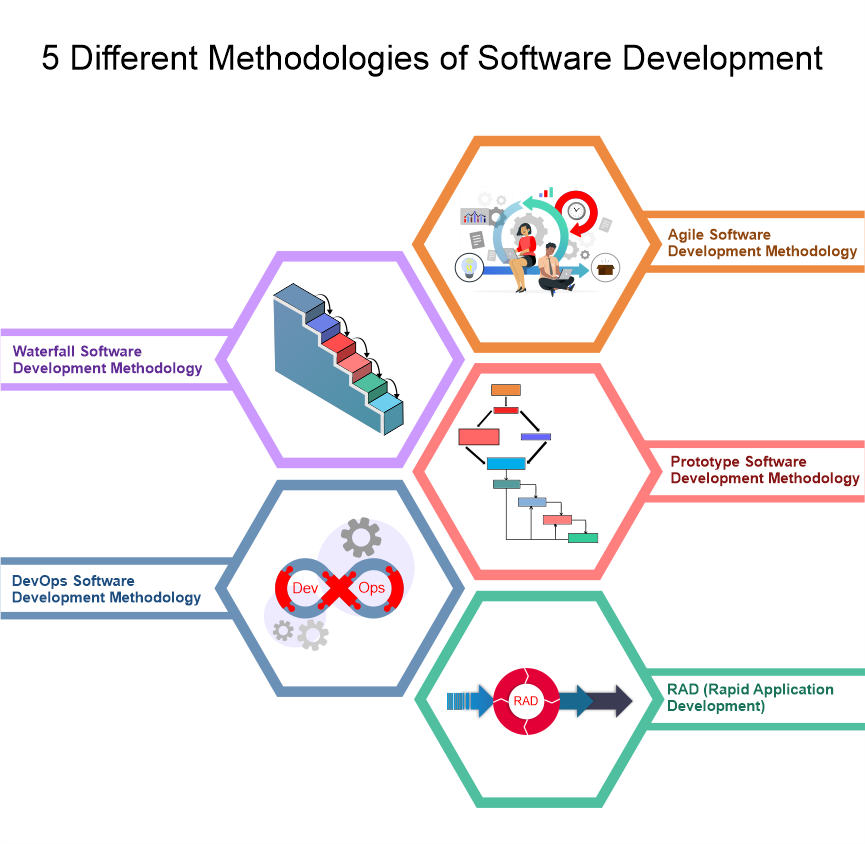5 Different Methodologies of Software Development
Now a day’s companies need software to manage their business’s many tasks and also helps to save money and time. Businesses are concentrating on developing scalable, feature-rich software that can address difficulties faced by both their clients and their own company. So, there are many different methodologies for this.
What is software development methodology?
The software development methodology is a framework for organizing, scheduling, and managing the process of creating an information system. Over the years, various approaches for developing software have been introduced. So, in this blog, we are going to discuss the different methodologies of software.
1. Agile Software Development Methodology: One of the most common software development approaches today is undoubtedly the agile methodology. With the agile methodology, software developers create a structured software management process. This enables the project to undergo periodic adjustments. Agile development methodologies place a strict emphasis on delivering business value as early as possible and continually, as shown through running, tested software.
Aspects of Agile:
• Customer satisfaction through timely, ongoing release of practical software.
• Agile refers to an iterative approach that minimizes waste and increases efficiency.
• Greater flexibility in the plan and simpler adaptation to various project changes.
• A general improvement in the standard of the output.
• Customer service agents provide frequent feedback and direct communication, eliminating any room for systemic speculation.
2. Waterfall Software Development Methodology: The waterfall methodology is still applicable in some projects today, despite having been in use for many years. Your team must finish each stage of this methodology. Follow the fundamental guidelines and perfect every last detail. This approach is rigid and linear. Only after the preceding stage is finished can a new one be started. This method lacks flexibility, so whatever the client and developer agree upon in the beginning must be carried out.
Aspects of Waterfall:
• The waterfall paradigm is highly basic, simple to comprehend, and employs methodology.
• No new phase can start until the previous phase is finished.
• Better time management and enforced discipline.
• You can identify the project's objectives using waterfall.
• Before development begins, all specifications and deliverables are laid out.

3. Prototype Software Development Methodology: The prototype approach enables developers to work on the prototype version of the eventual product rather than creating a fully functional software. utilising the waterfall methodology and placing a big emphasis on consumer input. Initial specifications are given, samples are offered by developers, and only once consumers have tested the samples' functionality is the final development started. It addresses a wide range of problems that frequently arise in a waterfall model.
Aspects of Prototype:
• The prototype model can serve as a valuable source of knowledge for UI/UX enhancements.
• Good at ironing out potential faults in the early development stage, which considerably minimises product failure risk.
• When necessary documents are absent, it aids in requirement analysis and gathering.
• High client and end-user participation throughout the development process.
• There is opportunity for improvement, which implies new requirements can be easily achieved.
4. DevOps Software Development Methodology: DevOps is a well-known concept that is drawing a lot of attention across all software development approaches due to the undeniable advantages it provides to its clients. The communication between the product development and operational teams is continuous (IT operations). It is dependent on continuous feedback, like many other agile processes, to assist teams in reducing risks, enhancing customer happiness, and saving time.
Aspects of DevOps:
• A quicker process the simultaneous operation of several ongoing processes makes it quicker and simpler for organizations to complete tasks on time.
• It might lessen human error.
• In a DevOps lifecycle, the client is the main focus.
• Higher quality systems lead to an improved client experience.
• Reliability with an increase in infrastructure and product developments.
5. RAD Software Development Methodology: When compared to other software development approaches, Rapid Application Development (RAD) yields solutions that are higher-quality and developed considerably more quickly. It makes use of various development approaches as support. It emphasizes frequent iterations and prototype releases. The procedure aids developers in quickly modifying their designs in response to regular feedback from stakeholders. The five stages of rapid application development are analysis and quick design, prototype cycles, testing, and implementation.
Aspects of RAD:
• The rapid application development paradigm aids in lowering the risk and requiring less work on the side of the software developer.
• Enables simple modification of the essential features while the software is still being tested.
• Real-time communication and feedback are possible between each side.
• Increased client satisfaction.
• It emphasizes on delivering working models to the client incrementally and iteratively.
Conclusion:
You can select the methodology that best meets the demands of your business and a software development company that understands you. The size of the development team, previous experience, project specifications, objectives, and financial concerns all play a role in selecting the best software development methodology. You may get in touch with skilled programmers at Career IT and Business Solutions Inc., an Edmonton, Canada-based Company that specializes in custom software development. It offers agile software development methodologies.
